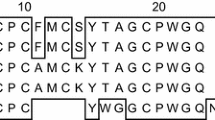Abstract
The sea anemone Actineria villosa expresses a lethal protein toxin. We isolated a novel 120-kDa protein, Avt120, from partially purified toxin and found it to possess extremely strong lethal activity. The 3,453-bp Avt120 gene translates to a 995-amino acid protein. The 50% lethal dose (LD50) of purified Avt120 in mice was 85.17 ng. Among several tested cell lines, Colo205 cells were most sensitive to Avt120: 50% of them were damaged by 38.4 ng/mL Avt120. Avt120 exerted ATP degradation activity (10 μmol ATP h−1 mg−1), which was strongly inhibited by ganglioside GM1 to decrease the cytotoxicity of Avt120.






Similar content being viewed by others
Abbreviations
- ADP:
-
Adenosine diphosphate
- ATP:
-
Adenosine triphosphate
- DTT:
-
Dithiothreitol
- FCS:
-
Fetal calf serum
- HPLC:
-
High performance liquid chromatography
- LD:
-
Lethal dose
- MEM:
-
Minimal essential medium
- MTT assay:
-
Methylthiazole tetrazolium assay
- PBS:
-
Phosphate buffered saline
- SDS-PAGE:
-
Sodium dodecyl sulfate–polyacrylamide gel electrophoresis
References
Bernheimer AW, Avigad LS (1976) Proc Natl Acad Sci USA 73:467–471
Bressler JP, Belloni-Olivi L, Forman S (1994) Life Sci 54:49–60
Bunc M, Drevensek G, Budihna M, Suput D (1999) Toxicon 37:109–123
Chethankumar M, Srinivas L (2008) Afr J Biochem Res 2:8–14
Finney DJ (1971) 3. CambridgeUniversity Press, London
Hara-Yokoyama M, Hirabayashi Y, Irie F, Syuto B, Moriishi K, Sugiya H, Furuyama S (1995) J Biol Chem 270:8115–8121
Hara-Yokoyama M, Kukimoto I, Nishina H, Kontani K, Hirabayashi Y, Irie F, Sugiya H, Furuyama S, Katada T (1996) J Biol Chem 271:12951–12955
Ho CL, Ko JL, Lue HM, Lee CY, Ferlan I (1987) Toxicon 25:659–664
Katayama T, Watanabe M, Tanaka H, Hino M, Miyakawa T, Ohki T, Ye LH, Xie C, Yoshiyama S, Nakamura A, Ishikawa R, Tanokura M, Oiwa K, Kohama K (2009) Am J Physiol Heart Circ Physiol 298:H505–H514
Laemmli UK (1970) Nature 227:680–685
Marino A, Valveri V, Muia C, Crupi R, Rizzo G, Musci G, La Spada G (2004) Comp Biochem Physiol C Toxicol Pharmacol 139:295–301
Mizuno M, Nozaki M, Morine N, Suzuki N, Nishikawa K, Morgan BP, Matsuo S (2007) Am J Pathol 171:402–414
Nagai H, Oshiro N, Takuwa-Kuroda K, Iwanaga S, Nozaki M, Nakajima T (2002) Biosci Biotechnol Biochem 66:2621–2625
Oshiro N, Iwanaga S, Nozaki M, Nakanose T, Uchida H (2001) Annu Rep Okinawa Prefect Inst Health Environ 35:133–136
Pratt MM, Otter T, Salmon ED (1980) J Cell Biol 86:738–745
Shiomi K, Kawashima Y, Mizukami M, Nagashima Y (2002) Toxicon 40:563–571
Suput D, Frangez R, Bunc M (2001) Toxicon 39:1421–1427
Uechi G, Toma H, Arakawa T, Sato Y (2005) Toxicon 45:761–766
Uechi G, Toma H, Arakawa T, Sato Y (2005) Protein Expr Purif 40:379–384
Uechi G, Toma H, Arakawa T, Sato Y (2010) Toxicon 56:1470–1476
Zhang L, Balcerzak M, Radisson J, Thouverey C, Pikula S, Azzar G, Buchet R (2005) J Biol Chem 280:37289–37296
Acknowledgments
We would like to thank Y. Araki for help with sea anemone collection and advice on evaluating the biological functions of the toxin. We also thank Dr. A. Takemura at Department of Chemistry, Biology and Marine Sciences, University of the Ryukyus, for supporting the amino acid sequence of Avt120.
Author information
Authors and Affiliations
Corresponding author
Rights and permissions
About this article
Cite this article
Uechi, Gi., Toma, H., Arakawa, T. et al. Characterization of a Novel Proteinous Toxin from Sea Anemone Actineria villosa . Protein J 30, 422–428 (2011). https://doi.org/10.1007/s10930-011-9347-8
Published:
Issue Date:
DOI: https://doi.org/10.1007/s10930-011-9347-8




